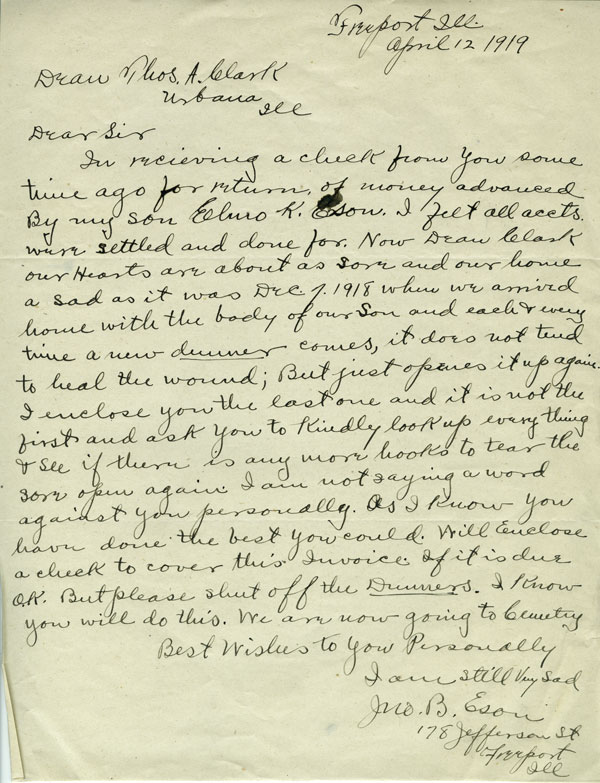This post is part two of the exhibit “Epidemic! Disease on Campus, 1918-1938.”
Despite being one of the deadliest natural disasters in history, the worldwide influenza epidemic of 1918 has been nearly forgotten. This unusually deadly influenza virus killed 675,000 people in the United States, a greater number than U.S. troop deaths in World War I (116,516) and World War II (405, 399) combined. Roughly 40 million people died worldwide from the early spring of 1918 through the late spring of 1919.[1]

Champaign-Urbana and the University of Illinois were not immune to the pandemic. Theaters and other public spaces closed their doors as a precaution against spreading the disease. J. Howard Beard’s emergency plan for epidemics began at the Health Services Station in late 1918, extending their hospital capacity from 30 to 400 beds.[2] Many universities closed their doors during the epidemic, but the University of Illinois remained open despite high absence rates of staff and students.
Unlike most influenza viruses that prey on the young and old, mortality rates for the 1918 influenza were highest for individuals aged 18 to 40, and more so for males than females. The influenza virus rarely caused death on its own; death followed because of the body’s immunological reaction to the virus. Thus, individuals with strong immune systems were more likely to die than those with weaker immune systems. [3] Every week for months, the Daily Illini published names of students who died from influenza and its complications.
As Dean of Students, Thomas Arkle Clark corresponded with the parents of infected students, notified them of medical changes, and, too often during this epidemic, expressed condolences and coordinated financial and material transactions after a student’s death. In a letter to Dean Clark after the death of her son, L.J. Haley wrote: “I assure you I appreciate the sympathy you extend to me in the loss of my dear son Milo. In his death I received a blow that I am afraid I will never recover from. We had planned so much for him and wrapped our whole future in him. I thank you for the interest you took in his welfare and I feel that he received the best care possible under the circumstances.”[4]

Elmer Eson, of Freeport, Illinois, died December 6, 1918 at the University hospital from pneumonia, following an attack of influenza. He was a member of Company I and Sigma Pi, and the fifteenth influenza victim at the University. Five months after his death, Dean Clark continued to correspond with the family about financial issues. In April of 1919, John B. Eson, father of Elmer, wrote a grievous letter requesting that Dean Clarke halt the repeated requests for debt payment. This letter is available for viewing to the right.[5]
Guy Ward Ellenberger, of Normal, Illinois, died in the University hospital of pneumonia developing from influenza on December, 9, 1918 at the age of 22. He sent a telegram to his mother, Amanda I. Ellenberger, shortly before his death: “Am still improving. However rather slowly. They will not let me write so will send this instead. I shall probably be all right in a few days. Do not worry if you do not hear from me very often.” [6] Upon his death, his mother was not as convinced about the quality of campus medical care as Milo Haley’s family. This reaction may be attributed in part to the assurance she received about his recuperation so soon before his death.
Despite Amanda Ellenberger’s misgivings about the quality of campus medical care and the substantial number of staff and students infected with influenza, J. Howard Beard’s preparations for just such an emergency insured that Illinois had one of the most successful outcomes of the influenza pandemic among universities.
[1]Thomas A. Garrett, “Pandemic Economics: The 1918 Influenza and Its Modern-Day Implications,” Federal Reserve Bank of St. Louis Review (March/April 2008): 75.
[2] Hospital and Health Service Reports, 1918-19, Record Series 41/2/33, University of Illinois Archives.
[3] Thomas A. Garrett, “Pandemic Economics: The 1918 Influenza and Its Modern-Day Implications,” Federal Reserve Bank of St. Louis Review (March/April 2008): 77.
[4] Office of the Dean of Students General Correspondence, Record Series 41/2/1, box 18, University of Illinois Archives.
[5] Ibid, box 17.
[6] Ibid.